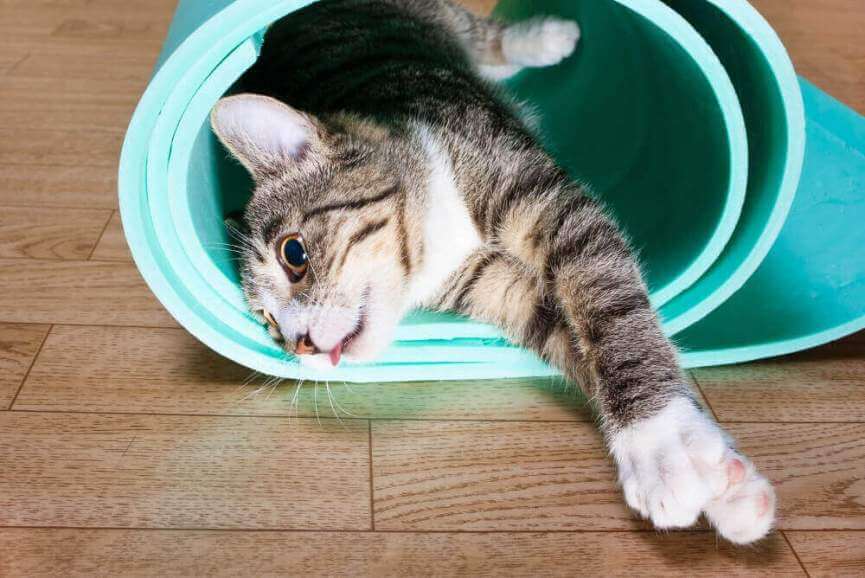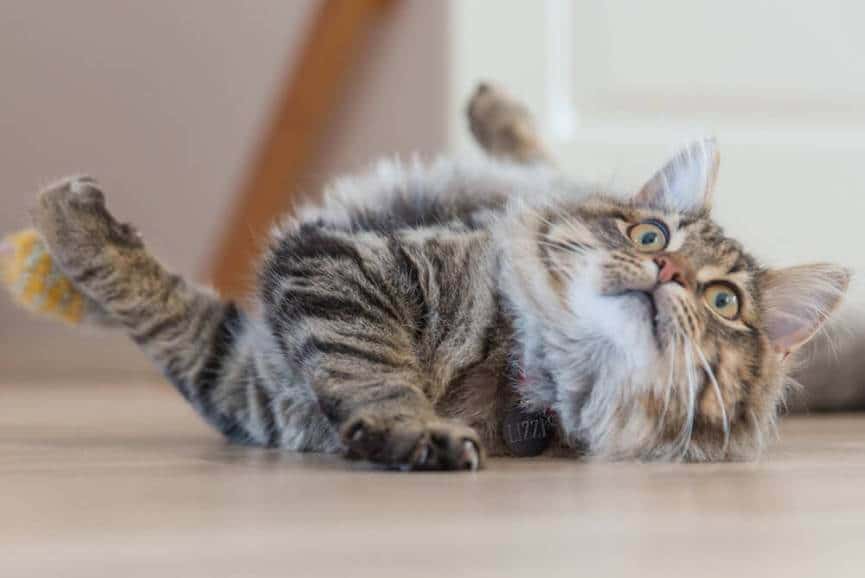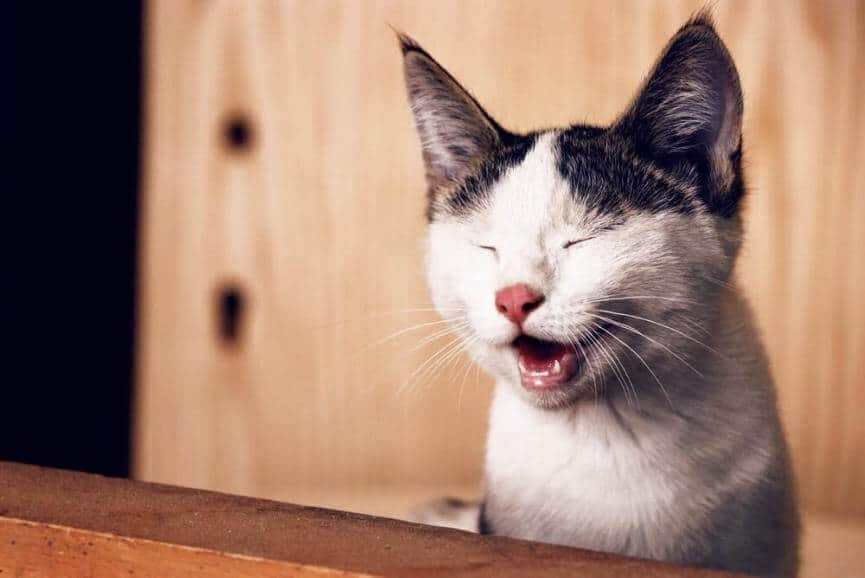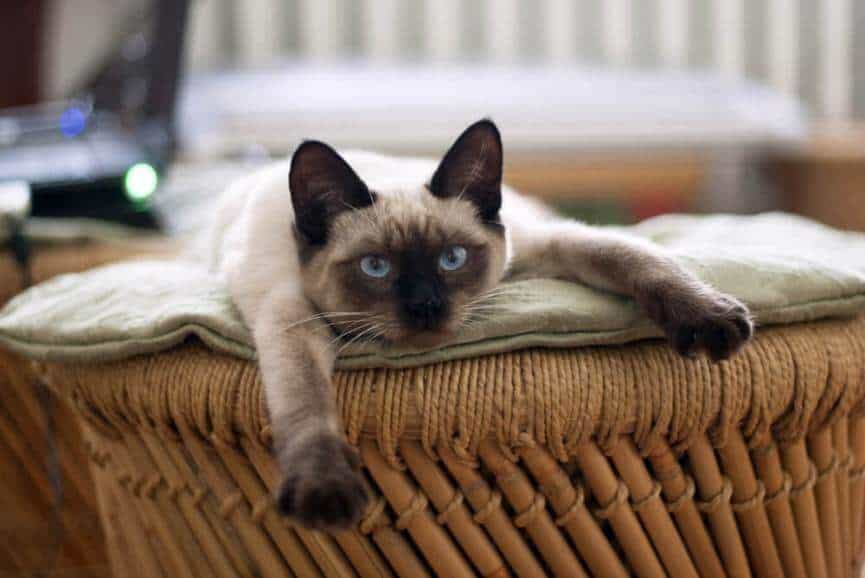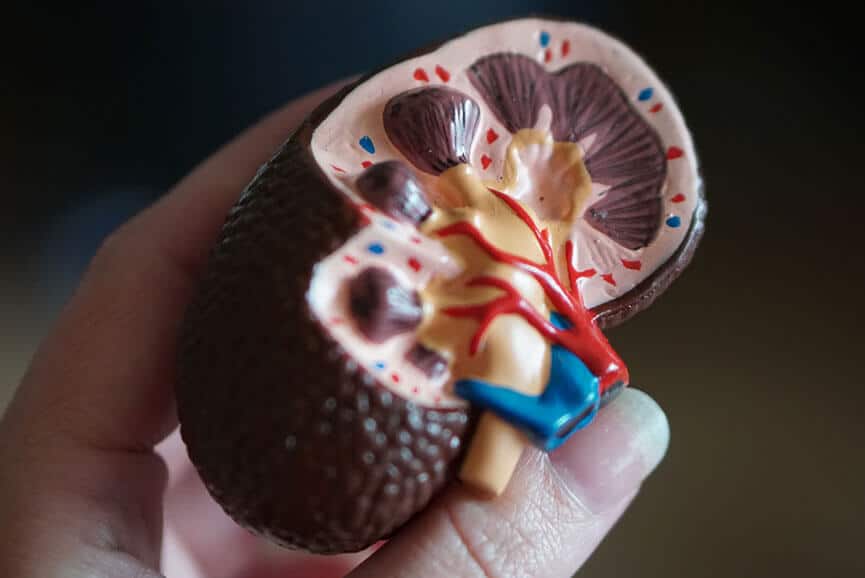If you are researching on cat with down syndrome, you have probably heard of Monty, a famous cat of the internet with some disabilities.
Cats are usually unique from one another, and most of their day to day activities seem cute and adorable to cat owners. Herein, physical and mental disorders affected cats are apparently more unique due to their unique characteristics.
It’s not necessary to think that every cat with a genetic disorder is affected by down syndrome. This is where most people get confused.
If you have a disabled cat and want to find out, if the disability is caused by down syndrome or not, this article has everything you need to know about the topic.
Understanding Down Syndrome and Why Does This Happen?
Down syndrome is a human disorder that affects people both physically and intellectually. The chromosomal defect causes an error in cell division, and this is the reason why this disorder occurs.
In humans, there are 23 pairs of chromosomes. These chromosomes contain parents’ biogenetic materials and pass these to their offspring.
The numbers of pairs aren’t the same for all species. For example, cherries and alligators have 16, and cats have 18 pairs.
When there is an extra chromosome instead of two, it causes such a genetic disorder. This additional chromosome appears in the 21st chromosome, and it’s called trisomy which we know as down syndrome.
Characteristics of People with Down Syndrome
Some traits of down syndrome in humans also appear in cats. Therefore, knowing those characteristics is necessary so that you can diagnose your cat.
People with down syndrome have a stunted appearance, and their mental condition is immature like a 9 years old child. Other common traits include larger tongue, abnormal outer ears, slanted eyes, crease in the palm, small chin, short neck, having poor muscle tone, etc.
The stunted grown issue leads to shorter stature and coordination problems. Their IQ level is somewhere around 50.
Can Cats Have Down Syndrome?
When cat owners notice mental and physical traits of people with down syndrome within their cats, they take that as cat down syndrome, which is not true whatsoever. Just because your cat shows specific characteristics of down syndrome disorder, it doesn’t necessarily mean the feline is affected with such disease.
As I have mentioned earlier, when the chromosome 21 is defected, only then down syndrome can affect a person. Cats have 18 pairs of chromosomes, so there is no chance for cats to have such disorder no matter how unusual the feline behaves and appears.
Why Do People Call It Cat Down Syndrome?
When it comes to having knowledge about human disorders, most people know only about down syndrome. That’s why even if a person has some other disorder, people will still address it as down syndrome due to their lack of knowledge about terminology.
Similarly, people don’t know much about cat disorders. Therefore, when they see something strange in the physical or mental condition in cats, they always address that as down syndrome.
If a cat has any genetic defect in its chromosome 15, or chromosome 16, the cat will bear with some disorder. But we cannot address that disorder as down syndrome. In fact, there are specific names for cat disorders.
When did you first hear about cat down syndrome? Is it from the internet? In most cases, it’s the celebrity cat from the internet named Monty who has some special abilities unlike other cats.
People addressed Monty as a cat with down syndrome, and it went viral. Since then, cat owners address any disorder related to cats as down syndrome.
Even some veterinarians use the term “feline down syndrome” in their diagnosis. This is solely because people don’t understand complicated terms, and as the symptoms are quite similar to down syndrome; stating any cat disorder as a down syndrome is easier and convenient for them to understand.
Cats with Down Syndrome Characteristics
Technically, cats cannot have down syndrome as they only possess 18 chromosomes. However, some genetic mutations can be the same in both cats and humans. If your feline has some physical or neurological abnormalities due to chromosomal defect, know that, it’s not uncommon.
Your cat may not respond when you call it or give any commands. During their young age, felines with any disability don’t grow equally compared to others, and it can be due to a genetic condition or lack of nutrition.
Various muscle issues appear as soon as they get older. Suffering from physical anomalies can also cause due to inbreeding or any other disease. These cats bump and frequently fall due to poor coordination.
Cats wrongly attributed to down syndrome have droopy ears, poor muscle tone, a wide set of eyes, squished noses, social and communication abnormalities, etc.
Furthermore, these special furballs show abnormal behaviors that are unusual to their species. Their meowing sounds quite different than other cats.
The most surprising thing about these special cats is, they are way too friendly than other home-grown cats. They behave so warmly even with strangers; they don’t shy away from them, which is rare to their species. This is the reason why special cats get special attention even from people who don’t have a cat.
Not Every Sign Indicates that the Cat has Some Disorder
If you notice one or more signs in your cat, you cannot come to a conclusion and attribute those signs to any disorder. Each cat is unique and different from others in some cases. Certain characteristics can be natural for some felines.
Just because someone falls while walking, you cannot tell that the person is suffering from any disorder. The same goes for the cats. Poor balancing and coordinating can be due to other diseases; physical injury, neuromuscular problem.
Abnormalities in Cats
As I have mentioned earlier, even if you see something abnormal within your cat, that doesn’t mean this is because of down syndrome. There can be some other reason behind it.
• Breeding Abnormalities
Inbreeding in humans opens the door for the baby to born with genetic disorders. The same goes for cats as well. When we want two closely related cats to mate to get desirable traits, the kittens can suffer from genetic defects and health complications.
Kittens born by inbreeding have congenital abnormalities, and they don’t grow to their full potential.
Abnormal eye set, crooked nose, misaligned jaws are issues associated with overbreeding.
Genetic Disorders that are Wrongly Associated with Down Syndrome
Most cat owners associate their pat’s unusual physical and behavioral issues with down syndrome due to misdiagnosis and lack of proper knowledge about cat disorders.
Cat disorders lead to physical deformity, and they all have their specific names and terms.
In most cases, disorders can only be detected by a vet. But you need to know about these cat illnesses and symptoms as well.
• Cerebellar Hypoplasia
The disorder is related to the cerebellum, which is a part of the cat’s brain that takes up a significant portion of the brain.
This disorder happens when the mother cat gets infected with parvovirus (FPV) during or before giving birth. Apart from FPV, it also causes due to lack of nutrition and having other infections.
Cerebellar hypoplasia usually appears when kittens start to walk during their 6 weeks of age.
It primarily affects the kitten’s ability to move and balance the body. Their poor coordinating skill affects motor movement as well.
As a result, their heads bob and limbs constantly tremble while walking most of the time. They look unsteady and clumsy. Affected cats cannot judge distance and bumps into things due to that reason as well.
• Klinefelter Syndrome
This genetic disorder is also known as male calico cat syndrome. It occurs due to an extra X chromosome in the cells of male cats.
Normally, male cats contain XY chromosomes; while on the other hand, females contain XX. When there is an extra copy of the X chromosome, it causes Klinefelter syndrome. However, this disorder rarely happens in some cats.
Cats with such disorder don’t have poor motor skills or deformed appearances; they seem perfectly fine.
However, some behavioral signs are linked with the disorder. The affected male cats show feminine characteristics which make them having an identity crisis.
In most cases, it’s hard to identify whether the affected cat is male or female. Sperm production of these cats is also interrupted due to the extra X chromosome, which makes them impotent and incapable of reproducing.
It’s highly recommended to spay or neuter cats with Klinefelter syndrome to reduce some traits associated with it.
• Distal Polyneuropathy
It’s a disease related to the peripheral nerves, which is commonly found in Birman cats.
Cats inherit the disease from their parents, and it manifests when they are 8-10 weeks of age.
The common traits of Distal polyneuropathy in cats include head tilt, muscle tremors, idleness, and seizures. In most cases, this disorder also brings pelvic limb ataxia, which causes incoordination within the nervous system.
The disease causes uncoordinated motor activity and makes them lose their balance when they try to move. Affected cats require hospital care so that they can get specific therapies to overcome the effects.
The only way to avoid having such disorder in kittens is to make a Birman cat mate with another breed.
• Feline Dysautonomia
It’s a neurological disorder which is also known as Key-Gaskell syndrome. The disease causes degeneration of nerve cells and eventually leads to the autonomous nervous system malfunctioning.
ANS controls body functions that include; heart rate, digestion, respiration, blood pressure, intestinal contractions, urination, perspiration, glandular, and salivation.
When ANS malfunctions, it also affects these essential body functions. As a result, cats have poor motor skills as well as the system in coordination.
Cats with Dysautonomia syndrome cannot judge distance. They fall too often and bump into things while they move. Furthermore, physical deformities such as protrusion of third eyelid and dilated pupils also appear in affected felines.
Cats may also show symptoms such as vomiting, diarrhea, nasal discharge, straining to urinate, muscle wasting, and difficulty in breathing.
The disease mostly affects cats under 3 years old. What the reason behind such a disorder is still unknown. However, veterinarians recommend cats to undergo a full physical checkup to identify which organs or areas are being affected by the disease.
What to Do If Your Cat Shows Signs of Down Syndrome?
By pen and paper, cats cannot be born with down syndrome disorder. However, if you notice the traits and characteristics of down syndrome in your cat, don’t need to panic. Your cat will do fine if you take some special care of it.
The first thing to do after you suspect there’s something wrong with your cat is to take it to a vet as soon as possible. He may perform some tests, including blood work, genetic testing, X-rays, and others to diagnose whether the disease is related to something physical or psychological.
After the diagnosis, your vet will prescribe and advise the necessary things you need to do to look after your cat.
Some people look handicapped cats for adoption because these cats are very special. They have a unique look, they act and behave uniquely compared to other normal cats.
And these cat owners are pretty successful at nursing, and you will find them very proud of their cats. That’s the passion we need to develop as animal lovers.
Cats and Kidney Disease
CKD is one of the most common diseases among older cats. In most cases, the disease is progressive as time goes. Therefore, CKD condition can get worse gradually. However, the decline rate varies from cats to cats.
Cat Kidney Disease Stages
Feline kidney diseases are of two types;
1. Renal Failure
It develops suddenly, within a matter of days or weeks, and affects cats of all ages.
The most common reason for renal failure is due to poison intakes, such as plants like pesticides, lilies, cleaning solutions, and some human medications. These are highly poisonous to cats.
Physical issues such as the broken pelvis, burst bladder, rapid dehydration, infections in kidneys, blockage of blood flow towards kidney, urethral blockage, and heart failure primarily lead to this kidney issue.
Renal cat issue can be reversed completely if it’s diagnosed in time, and cat kidney disease treatment is performed correctly.
2. Chronic Kidney Disease
As I have mentioned earlier, middle-aged and older cats develop this disease. Cats that are 7 years of age have a high risk of developing this chronic disease.
Unlike the renal disease, it cannot be reversed and it isn’t curable. But if you take good care of your feline, you will be able to slow down CKD’s progression rate and prolong its life.
Symptoms of Kidney Problem in Cats
Certain signs show your feline is undergoing through this chronic kidney issue. These are;
- Cats urinate frequently. Their ability to hold water declines; as a result, they urinate too often. Sometimes it gets tough to hold the urine, and it comes before cats reach the litter box.
- The defected kidney will require more water. So, a defected cat will drink more water than before, actually a lot of it. This is because of its frequent urinating.
- Dilute urine produces bacteria, and it causes infections in the kidney and bladder.
- Massive weight loss and less appetite.
- Bloody, cloudy urine along with vomiting, and diarrhea.
- Ulcer in gums and tongue.
- Tongue seems brownish.
- Constipation.
- Dry coat.
- Weakness.
Early Kidney Disease in Cats
Did you know that early kidney disease in cats often goes unnoticed? You need to pay attention to when caring for your pets. We can compare them with humans because they fall sick, feel hungry, and sometimes lose appetite. Stage 1 kidney disease in cats is a vital health issue that we need to pay attention to regardless of a cat’s age. This condition needs proper treatment as well as nutrition. You do not need a miracle to keep your kitty happy, but good food and treatment.
Causes of Early Kidney Disease in Cats
• Infection
• Virus
• Dehydration
• Gum disease
• Some cats can inherit this disease from their parents
This disease is common in older cats and rare in rare cats. One out of three cats suffers from this condition though it is not easy to discover it. This is because quite a number of cats show no outward signs of kidney disease until it advances.
Diagnosis and Treatment
Your cat will undergo a series of tests to find out if the disease exists. Vets normally look at the levels of biochemical products as well as protein. Today, vets can diagnose both acute and chronic renal failure much earlier. Research shows that this disease is easier to treat with meal plan changes at stage one.
Nutrition
Nutrition is the key element in your pet’s wellness. Make sure that you choose the right cat food, especially for young and aged pets. Did you know that Phosphorous is natural in protein-rich foods such as fish and meat? Monitor Phosphorous levels, especially in cats with chronic disease.
Cat Scratch Disease
What is cat scratch disease?
This infection occurs after a cat scratch, licks, or bites. There is a bacterium in the cat’s saliva that causes this disease. Cats get this disease from fleas. As others refer to it, small cat scratch or cat-scratch fever is not a severe illness in humans. It can only affect people with a weak immune system or small children. It can affect people with:
• Cancer
• Acquired immunodeficiency syndrome (AIDS)
• Diabetes
Symptoms of cat scratch fever
Sore
• Red bump
• Blister
It takes a number of 3 to 10 days for the symptoms to show. In some cases, lymph node infection develops. If it bites you on your arm, then the area around your armpit may swell. Small cat scratch can worsen if you are not careful. It is also advisable to contact your vet if you notice the following problems:
• A red area around a cat scratch
• A bite that is not healing
• Painful lymph
• Fever that lasts for several days bone and joint pain
How to treat small cat scratch
There is no cause for an alarm because this is not a serious condition, especially if it is a small scratch. First, clean the scratch immediately using warm salty water. Dress scratch properly to prevent further problems.
In most cases, this disease clears up by itself. Use an over-the-counter painkiller to relieve the pain. In case the symptoms do not disappear soon, use antibiotics. Seek medical help immediately for more information
How to prevent small cat scratch
Ways that you look into to prevent cat-scratch disease:
• Wash your handles well after handling your pet
• Play gently with your pet to avoid scratches and bites
• Control fleas in your home to prevent your cat from contracting the bacteria
• Do not let your pet lick you, particularly around your eyes, mouth as well as an open wound.
• Avoid keeping feral cats
Did you know that young cats are more likely to carry the bacteria than old ones? That is why houses with kittens have higher rates of this infection.
What you Need to Know about IBD in Cats
Does your cat vomit or diarrhea? In the recent past, most cats suffer from colitis problems. Persistent vomiting and diarrhea in cats is a sign of IBD. It affects different parts of the gastrointestinal tract. If it affects the stomach, it causes gastritis.
What are the Symptoms of IBD in Cats?
Large amount of Diarrhea
• Vomiting
• Weight loss
• Increased appetite
If you notice these signs and symptoms, find a way to contact your vet before it is too late. Did you know that a good number of pets dies as a result of this condition?
Treatment for IBD in Cats
IBD in cats’ treatment consists of a combination of medication and nutritional therapy. It is not easy to stress the significance of nutritional therapy in your pets, though. According to vets, a cat suffering from chronic GI disease only requires good nutritional therapy and not steroids. The same goes for pets suffering from IBD. Avoid over-the-counter meals and visit your vet for a good prescription.
For that matter, a good diet is hydrolyzed protein, special dietary meals, and low-fat novel protein. Keep in mind that you cannot cure this disease, but you can manage it. The treatment involves a series of trial and error prescriptions, especially in cats with more than one gut challenge.
Final Words
Don’t take your cat’s well-being lightly. If you notice anything unusual, give it a high priority and get the issue diagnosed soon.
If the vet tells you about something related to a genetic disorder, don’t freak out. You will find lots of examples of cats with down syndrome on the internet, and still, those felines are doing great in their day to day activities.
Your furball can normally survive as other cats; all you need to do is to take some extra care of it. Today or tomorrow, you will get used to it with its unique behavior.

